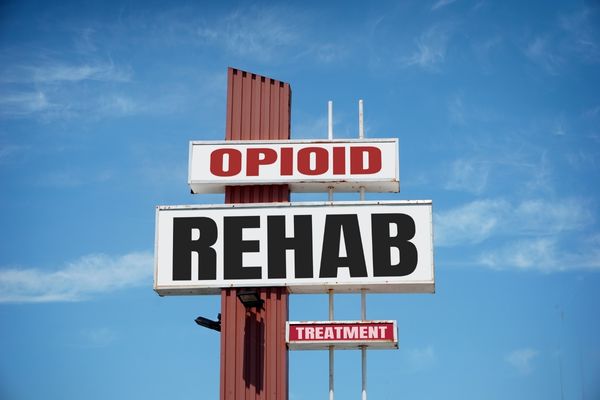Opioids can be natural (opium, morphine, codeine, etc.), semi-synthetic (heroin), or fully synthetic (fentanyl, methadone, etc.). These drugs have legitimate medical uses, generally for chronic and post-surgery pain. However, they also have a high potential for abuse and addiction.
As of 2022, opioid use disorders affect over 16 million people worldwide and close to 3 million in the US alone. Over 120,000 deaths every year are attributed to opioids. Being so widespread, learning to recognize the symptoms of opioid abuse and addiction is essential to help someone struggling with addiction.
While some signs of opioid addiction are easy to recognize, others can indicate different ailments. Here are the most common symptoms of opioid addiction to watch out for.
1. Constricted Pupils
“Opiate pupils” are a common sign of opioid abuse. When people use opioids, their pupils shrink, and they no longer change size as a response to different intensities of light exposure (as they usually would).
One of the side effects of abusing opioids is altering how the iris sphincter muscle works, making it permanently contract while the opioid is in effect. Opioid abuse has other potentially severe but little-known effects on vision, such as eye infections that could lead to pain, eye discomfort in bright light (photophobia), and vision loss.
2. Borrowing or “Losing” Medication
People addicted to opioids will likely ask friends or family members for their prescriptions. They won’t necessarily ask for specific drugs, but they’ll go to great lengths to get their hands on some medications. They might also claim that they “lost” their medication and need a refill or will ask someone for multiple pills until their refill is ready.
3. Doctor and Pharmacy Shopping
To help control opioid addiction, doctors and pharmacies have stringent prescription guidelines to follow. The idea is that if patients no longer have access to prescribed opioids, they will discontinue their use.
However, people addicted to opioids will engage in “doctor shopping,” a practice that involves going to different doctors to obtain multiple prescriptions. This way, they can continue to maintain a supply of opioids.
4. Noticeable Changes in Appearance
When someone abuses opioids, they’re more likely to neglect their appearance and personal hygiene. You’ll likely notice unexplained weight loss, less care for their appearance, and poor hygiene, like not bathing or washing their hair. You will also notice puncture wounds, scabs, and sores if they use IV drugs.
5. Changes in Social Circles
Surrounding one’s self with others who use drugs or otherwise enable drug use is one way to justify what would otherwise be a clear poor choice. It is a way to avoid guilt for making bad decisions. aturally, people can and do change and expand social circles. That’s not a cause for alarm on its own. But if a loved one shows signs of opioid abuse and has a sudden change of social circles, that may be an additional cause for concern.
6. Neglecting Responsibilities
When someone is addicted to a drug, their entire life eventually revolves around obtaining and consuming them. This makes establishing or maintaining personal and professional relationships with them hard due to the excessive attention they place on their drug use and recovering from drug use.
7. Risky Behaviors
Being addicted to any substance impairs judgment and may lead someone to risk their health and the health of others by engaging in risky behavior. This may include unprotected sexual relations and driving under the influence.
8. Obsession with Obtaining and Using Opioids
Drug addiction is characterized by drug-seeking behaviors, compulsive drug use, and the inability to interrupt use regardless of negative consequences. People addicted to opioids may try to manipulate their loved ones into providing them with opioids, spend large amounts of money on opioids, visit multiple doctors searching for prescription opioids (doctor shopping), and engage in other drug-seeking behaviors.
Bear in mind that they will not hesitate to lie about pain to receive prescriptions for opioids. They will go to lengths to steal from friends and family to continue their opioid supply.
9. Changes in Mood
Opioid addiction is associated with various behavioral changes, including unexpected and sudden mood changes. This looks like going from extreme joy to anger in short periods due to unpredictable triggers. People abusing opioids may also experience sudden, unprovoked outbursts, mainly when dealing with withdrawal symptoms.
Other psychosocial symptoms include depression, paranoia, and irritability.
10. Withdrawal Symptoms
Withdrawal syndrome is an array of symptoms caused by the absence of the drug that the body has become used to receiving. Withdrawal symptoms may appear 12 to 48 hours after the last use and may last 10 to 20 days. Suddenly interrupting opioid use without treatment for withdrawal symptoms can be risky, so going through withdrawals in a medical setting is essential.
The most common opioid withdrawal syndrome symptoms are:
- Severe anxiety
- Restlessness and insomnia
- Goosebumps and shaking
- Frequent yawning
- Runny nose and watery eyes
- Abnormally dilated pupils
- Aches around the body
- Profuse sweating
- Vomiting, nausea, diarrhea, and stomach cramps
- Fever
- Rapid breathing and heartbeat
- High blood pressure
- Hallucinations
- Seizures
The Importance of Identifying the Signs of Opioid Addiction
Identifying signs of opioid addiction early and seeking treatment can be a lifesaver for loved ones who would’ve otherwise never sought help by themselves.
If you notice these signs in a loved one, seek help to schedule a professional intervention. When your loved one is ready, support them in seeking addiction treatment. Recovery is a long and uphill battle, but it’s worth fighting for. Be there for your loved one every step of the way, and seek help and support for yourself.
